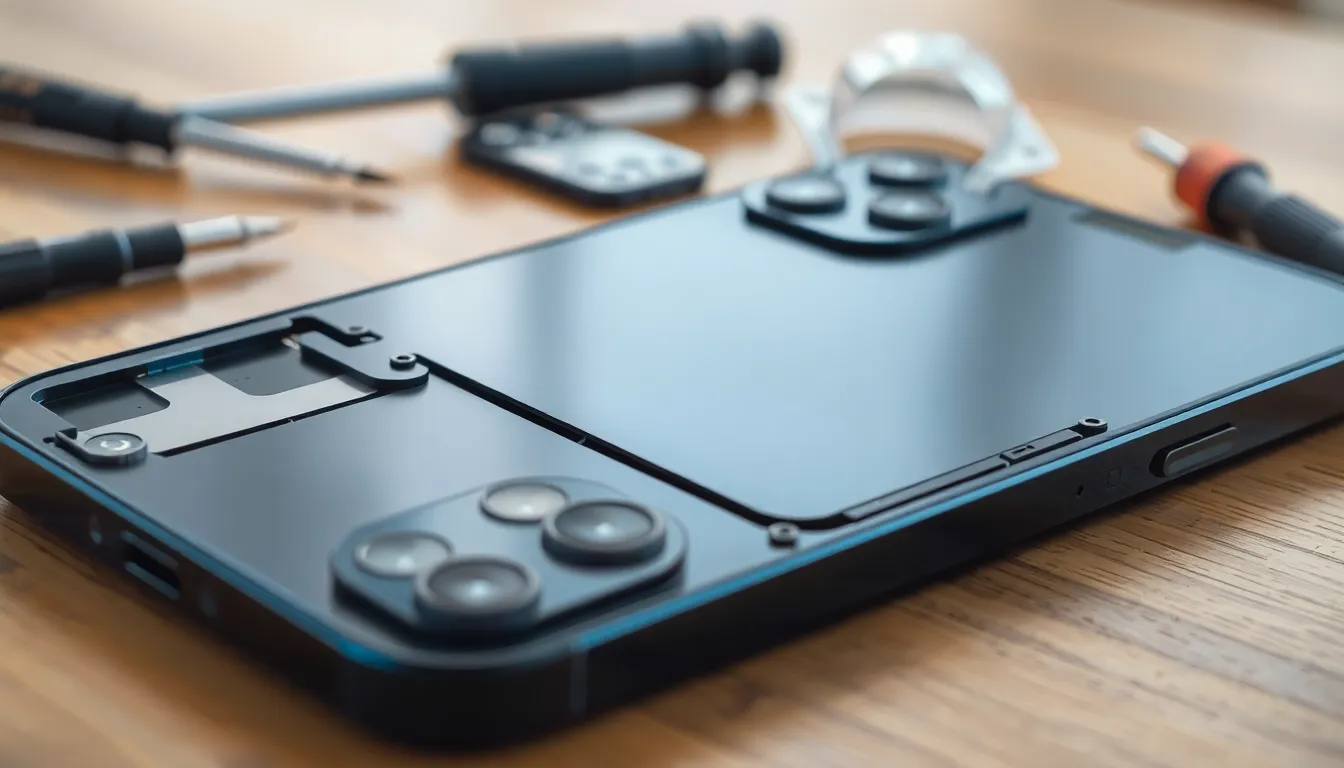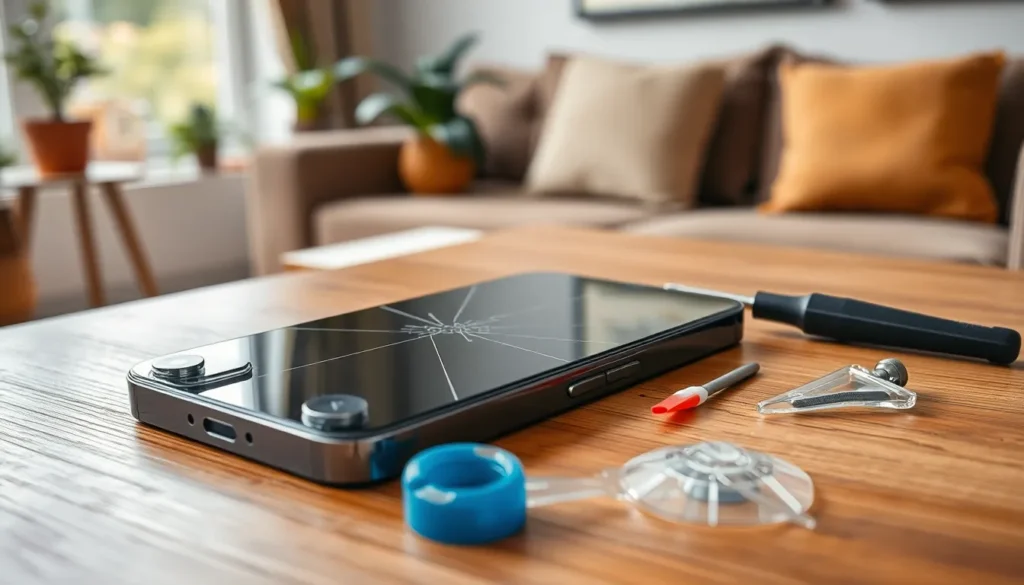Table of Contents
ToggleCracked the back of your iPhone 13 Pro Max? Don’t worry, you’re not alone. It happens to the best of us—one moment you’re taking a selfie, and the next, your phone decides it wants to audition for a role in a horror movie. But before you panic and start contemplating a life without your trusty device, let’s talk about the cost of repair.
Overview Of iPhone 13 Pro Max Back Replacement
Replacing the back of an iPhone 13 Pro Max typically involves several factors, including repair location and service provider. Costs can vary widely based on whether individuals choose authorized Apple services, third-party repair shops, or DIY methods.
Authorized Apple service providers generally charge between $599 and $699 for back replacement. Third-party repair shops may offer lower prices ranging from $200 to $400, depending on the shop’s reputation and parts used.
Warranty status influences pricing as well. If the device is under AppleCare+, users might pay only a service fee around $99. It’s essential to consider quality over price, as third-party parts may affect device performance and reliability.
DIY enthusiasts often seek information online. Detailed repair guides and videos simplify the process, but costs for parts fluctuate, typically ranging from $100 to $250. Individuals must assess their comfort level with technical repairs when considering this option.
Repairs take approximately one to three hours depending on the complexity of the job. Timely services minimize device downtime, enabling users to resume normal usage quickly.
Repair quality affects both immediate functionality and long-term durability. Picking a reputable service provider maintains repair standards and prevents future issues.
Knowing where to get repairs done, along with expected costs, empowers iPhone 13 Pro Max users to make informed decisions about fixing their devices.
Factors Affecting Replacement Cost

Several factors influence the cost of replacing the back of an iPhone 13 Pro Max. Understanding these can help users make informed decisions.
Genuine vs. Third-Party Parts
Choosing between genuine Apple parts and third-party components significantly affects costs. Genuine parts typically cost more, ensuring quality and compatibility with the device. Prices for these parts, including labor, range from $599 to $699 at authorized services. Third-party parts generally reduce overall expenses, with repair prices ranging from $200 to $400. While third-party options can save money, they may compromise device performance and longevity, potentially leading to further issues down the line. Users concerned about reliability should weigh the benefits of genuine parts against the savings of third-party options carefully.
Warranty and Apple Care Considerations
Warranties and AppleCare+ add another layer to the cost considerations. Users with AppleCare+ often face a minimal service fee of about $99 for back replacements, which can be significantly cheaper than out-of-warranty repairs. This option encourages users to invest in AppleCare+ for long-term savings. On the flip side, repairing through unauthorized service providers can void existing warranties, leading to potential long-term costs. Assessing the current warranty status and any AppleCare+ plans helps users determine the most financially viable route for their repair needs.
Cost Breakdown
The cost of replacing the back of an iPhone 13 Pro Max varies significantly based on repair options and service providers. Understanding these costs helps users make informed decisions.
Service Fees from Apple
Authorized Apple services typically charge between $599 and $699 for back replacement. This pricing reflects the use of genuine Apple parts, ensuring quality and compatibility. Customers with AppleCare+ enjoy a much lower fee, paying around $99 for the service. While these authorized repairs offer high standards, users often face longer waiting times due to appointment slots and parts availability. Opting for Apple means assurance in service but comes at a premium price.
Cost of Third-Party Repairs
Third-party repair shops present a more budget-friendly alternative. Prices at these shops generally range from $200 to $400 for back replacement. Many repair centers provide quick turnaround times, often completing repairs within a few hours. However, third-party repairs carry risks regarding part quality and device performance. While users may save money, it’s crucial to investigate the reputation and reliability of the chosen repair shop. Users often find that while costs are lower, potential trade-offs in quality may arise.
Where to Get Repairs
iPhone 13 Pro Max users have several options for back replacement repairs. Choices range from authorized Apple service providers to local repair shops.
Authorized Service Providers
Authorized service providers ensure high-quality repairs using genuine Apple parts. Repair costs typically range from $599 to $699, which reflects the use of these authentic components. Access to professional technicians guarantees that the repair meets Apple standards. Customers receive peace of mind, knowing their warranty remains intact. Scheduling an appointment is easy via the Apple website or the Apple Support app. Users should consider the certified provider’s pros and cons based on their specific needs.
Local Repair Shops
Local repair shops often present a more affordable option for back replacement. Charges usually fall between $200 and $400, making them budget-friendly alternatives. While they may not use genuine Apple parts, many establishments offer reasonable quality, allowing users to weigh cost against performance. Fast service is another appealing factor, with many repairs completed within a few hours. Researching reviews and ratings for these shops can help ensure a satisfactory experience. Local repair shops provide a viable choice, especially for those mindful of expenses.
Tips for Saving on Replacement Costs
Exploring options can lead to significant savings on back replacements. Consider seeking out third-party repair shops that charge between $200 and $400 instead of opting for authorized Apple services, which typically cost between $599 and $699. Researching local repair shops helps identify providers with strong reputations and competitive pricing.
Utilizing AppleCare+ offers deeper savings. Users enrolled in AppleCare+ often face a minimal service fee of around $99, making official repairs much more affordable. When evaluating repair shops, reading customer reviews can guide decisions and highlight where to find reliable services.
Assessing the condition of the device aids in deciding whether a DIY repair is feasible. Parts for DIY repairs range from $100 to $250, often making this route more budget-friendly for those with technical skills. Taking the time to watch tutorials or guides can simplify the process and enhance success rates for DIY repairs.
Prioritizing quality remains crucial. While third-party parts may save money, they can impact device performance and longevity. Users should balance potential savings with the quality and compatibility of replacement parts when making choices.
Lastly, discussing repairs with friends or family can provide insights and recommendations. Personal experiences often reveal hidden gems for affordable repairs and reliable service. Following these tips can effectively lower costs while ensuring the iPhone 13 Pro Max retains its functionality and appeal.
Replacing the back of an iPhone 13 Pro Max can vary significantly in cost depending on the chosen repair option. Users have the flexibility to select between authorized services and third-party shops while also considering DIY repairs. Each choice comes with its own set of advantages and potential drawbacks.
While authorized repairs ensure high quality and maintain warranty integrity, they come at a premium price. On the other hand, third-party repairs offer a more budget-friendly alternative but may compromise on quality. For those with AppleCare+, the minimal service fee presents a cost-effective solution. Ultimately, users should weigh their options carefully to find the best balance between cost and quality, ensuring their device is restored to optimal performance.







